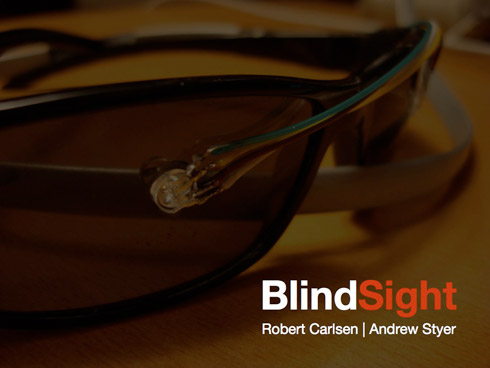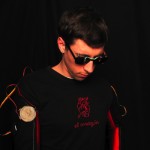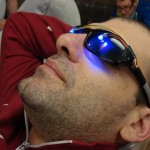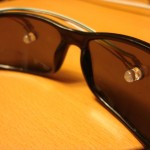
BlindSight aims to explore synesthesia by associating certain body positions with visual hallucinations induced by photic stimulation. In other words, flashing lights at various frequencies seems to cause visual patterns to appear for the viewer. Simple wearable sensors will adjust the frequency of the flashes and thus provide various patterns.
In the September 2008 edition of the journal Cortex, Dominic H. ffytche describes a study which employed flashing goggles to induce visual hallucinations for the purpose of analyzing brain activity with MRI. The study indicates that flashing frequencies between 5-30Hz at a certain intensity caused participants to describe perceiving hallucinations (Purkinje patterns) and produced a measurable change in the brain activity.
Although the patterns may differ for each viewer, they seem to be the consistent for the viewer at a given frequency. Based on this observation, we hope to create a relationship between the user’s body movements and the corresponding changes in visual hallucinations. The ideal scenario would be to enable a user to generate an association between certain Purkinje patterns and the orientation of the body relative to itself, thus representing a small portion of our sense of proprioception.
 Much of this project stems from several separate influences. First, the protagonist of William Gibson’s “Neuromancer” uses electrodes/glasses to jack into cyberspace, which is depicted as a three-dimensional space largely visualized as colored geometric shapes. Second, Robert’s general jealousy of individuals whom describe themselves as synesthetes, those who experience certain senses crossing over, ie. seeing certain letters as colored or hearing certain visual motion. Finally, Andy’s interest in sensing body movement as a system rather than as isolated and disjointed movements.
Much of this project stems from several separate influences. First, the protagonist of William Gibson’s “Neuromancer” uses electrodes/glasses to jack into cyberspace, which is depicted as a three-dimensional space largely visualized as colored geometric shapes. Second, Robert’s general jealousy of individuals whom describe themselves as synesthetes, those who experience certain senses crossing over, ie. seeing certain letters as colored or hearing certain visual motion. Finally, Andy’s interest in sensing body movement as a system rather than as isolated and disjointed movements.
Initial user testing of the glasses has provided strong reactions and most participants report perceiving patterns which change in response to frequency shift. Participants generally indicate that the experience is pleasant — there is concern, however, that the prototype glasses may overpower the effect by providing too much illumination intensity.
As we experiment to determine the levels of discernible patterns within the available frequency range, we thought it best to limit our focus to the upper body for this prototype – and possibly the arms alone. There are many unknowns in this sort of visual stimuli, and limiting the movement will allow us to explore the range of movements that can be incorporated into a system like this. We are currently experimenting with various sensors and inputs – flex sensors and tilt switches are the current favorites – to determine how best to map arm movements to particular frequencies (and therefore particular hallucinations). Another direction for exploration is the event as frequencies change. Several participants have expressed strong reactions when the patterns initially change. Perhaps alternating between frequencies could provide another dimension to the expressiveness of the glasses.
Robert was first introduced to this visual effect by Mitch Altman’s Sound and Light Machine (aka. the Brainwave Glasses) as described in Make: Volume 10.
BlindSight was created for Kate Hartman’s Thinking Physically class in the Interactive Telecommunications Program at NYU. The documentation of the project’s presentation is also available.


Leave a Reply
You must be logged in to post a comment.